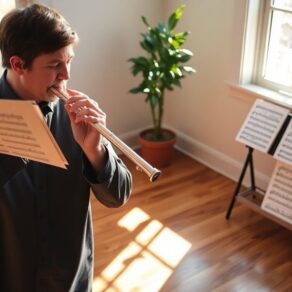To create emotional flute music, you need to blend skill with heartfelt expression. Start by mastering breath control; it shapes each note and adds emotional depth. Experiment with dynamics, phrasing, and articulation, ensuring each phrase flows naturally. Use expressive pauses for dramatic moments, pulling your listeners into the narrative. Incorporate improvisation to let your emotions guide you beyond the written score. Choose repertoire that resonates personally, tapping into the shared experience between you and your audience. With these techniques, you'll transform mere notes into a mesmerizing emotional journey that invites connection and understanding. There's more inspiration waiting just ahead!
Key Takeaways
- Focus on controlled breath to shape notes, enhancing emotional expression and creating a resonant sound that connects with the audience.
- Utilize dynamics and articulation to craft musical phrases, employing expressive pauses for emotional impact and narrative depth.
- Incorporate improvisation to inject spontaneity and authenticity, allowing personal storytelling to guide your emotional expression.
- Select repertoire thoughtfully, choosing pieces with emotional depth, including lesser-known works that resonate personally and foster audience connection.
- Experiment with contrasting styles in your performances to enrich emotional expression and create a dynamic, relatable experience for listeners.
Understanding Musical Emotion

Music has the power to evoke feelings just as vividly as a painting captures a sunset. When you explore the domain of flute music, you're not just playing notes; you're engaging in a profound form of musical expression that can resonate deeply with others. Each breath you take, each note you produce, carries an emotional weight that can transport your listeners to places of joy, sorrow, or nostalgia.
Understanding musical emotion is vital for creating pieces that connect on a deeper level. Think about the emotions you want to convey. Is it the exhilaration of a bright morning, or the wistfulness of a quiet evening? Your flute can express these sentiments, allowing listeners to feel what you feel. The emotional resonance of your music comes from the choices you make—dynamics, phrasing, and even silence. These elements are your palette, and they help paint the emotional landscape of your composition.
As you play, remember that vulnerability can be your greatest strength. When you infuse your music with authenticity, you invite your audience to join you on this journey. They won't just hear the notes; they'll feel the emotions behind them, forging a connection that transcends words. Incorporating techniques like diaphragmatic breathing can significantly enhance your ability to express these emotions through your flute.
Ultimately, understanding musical emotion isn't just about technique; it's about creating a shared experience that brings people together, fostering a sense of belonging through the universal language of music.
Techniques for Dynamic Playing

When you explore the world of dynamic playing, the essence of your expression comes alive. Embracing techniques that enhance your dynamic expression can transform mere notes into a heartfelt story.
Start by focusing on your breath. A deep, controlled inhale allows you to release a full, resonant sound, while varying your exhale creates a tapestry of dynamics. Practice playing with a soft touch, gradually increasing the volume, then pulling back again. This ebb and flow mimics the emotional resonance of a conversation, inviting your audience to lean in.
Next, experiment with accents. A well-placed accent can punctuate a phrase, drawing attention to the emotion behind it. Use your fingers to articulate these accents sharply, while your breath maintains the underlying smoothness. This contrast invites listeners to feel the highs and lows of your music.
Don't forget about vibrato. A slight variation in pitch can add warmth and depth, enhancing the emotional connection. When you combine vibrato with dynamic shifts, you create a rich landscape that captivates your audience. Additionally, focusing on airflow control can significantly influence the dynamics of your performance, allowing for greater expressiveness.
Finally, listen closely to other flutists or musicians. Analyze how they use dynamics to evoke feelings. Absorb their techniques and integrate them into your own style, finding ways to make them uniquely yours.
Mastering Phrasing Skills

While mastering phrasing skills, you'll discover how to shape your musical ideas into compelling narratives that resonate deeply with your listeners. It's not just about playing notes; it's about creating a journey through your music. Think of your melody as a story, where each rise and fall in the melodic contour conveys a different emotion.
As you play, focus on how you can use expressive pauses to enhance your phrasing. These pauses can serve as breathers for both you and your audience, allowing the emotions to settle in and create a sense of anticipation. Imagine holding a note just a beat longer, letting the silence draw your listeners in, making them keen for what comes next.
Be mindful of how dynamics and articulation influence your phrasing. A softer touch can evoke vulnerability, while a more forceful attack might express passion or urgency. Experiment with varying your phrasing lengths; some phrases might benefit from being shorter and punchier, while others might unfold slowly, like a gentle wave.
Practice connecting phrases seamlessly, weaving together a tapestry of sound that feels organic and alive. By actively engaging with your music in this way, you'll cultivate a deeper connection not just with your instrument, but also with your audience. Incorporating techniques such as articulation and dynamics into your practice can significantly enhance your ability to convey emotion through phrasing.
When you master phrasing, you're not just playing notes; you're communicating, inviting others to feel and belong within the world you create.
The Importance of Breath Control

How can you elevate your flute playing to evoke more profound emotions? The answer lies in mastering breath control. Your breath is the lifeblood of your music, shaping each note and bringing your emotional expression to life. When you control your breath patterns, you create a more dynamic and expressive sound, allowing listeners to connect deeply with your music.
Think about how your breathing is tied to your emotions. When you feel joy, your breath might quicken; in sadness, it may become slow and deliberate. By mimicking these natural rhythms in your playing, you can convey the full spectrum of human experience.
Experiment with varying your breath—take deep, sustained inhalations for long, lyrical phrases or quick, sharp bursts for more intense moments. This level of nuance can turn a simple melody into an emotional journey. Incorporating diaphragmatic breathing techniques can further enhance your control and support for these expressive moments.
Breath control also enhances your phrasing. Each phrase deserves its own breath pattern, reflecting the emotional arc of the music. Take time to find the right moments to breathe, allowing your phrases to swell and recede naturally.
It's not just about playing the right notes; it's about infusing each note with the breath of life.
Using Articulation to Convey Feelings

Breath control lays the foundation for expressive flute playing, but it's articulation that adds the intricate brushstrokes to your emotional canvas. Think of articulation as the heartbeat of your music; it shapes the tone color and brings your feelings to life. Each note can be a whisper, a shout, or a gentle caress, depending on how you choose to articulate it.
When you use staccato, you're creating a playful, detached energy that can evoke joy or excitement. In contrast, legato allows your notes to flow seamlessly, wrapping your audience in a warm embrace of emotion. By mastering these expressive techniques, you'll reveal new dimensions in your playing.
Try experimenting with accents, emphasizing certain notes to add intensity and urgency, making your listeners lean in closer, enthusiastic to feel what you're feeling.
Don't shy away from dynamics, either. Varying your articulation in tandem with your volume can create a rich tapestry of sound. For instance, a soft, breathy articulation can convey vulnerability, while a bold, sharp attack can express confidence and strength. Mastery of articulation techniques enables highlighting of melodic motifs that resonate with your emotions.
As you explore these nuances, remember that each choice you make is a reflection of your inner world. Articulation is your voice, your unique way of sharing your story. Embrace it, and let your flute become the vessel through which your emotions flow.
Connecting with your audience on this level not only enhances your music but also fosters a sense of belonging—an unspoken bond forged through shared feelings.
Incorporating Improvisation

In the vibrant domain of flute music, improvisation serves as a powerful tool for emotional expression. It invites you to step beyond the confines of written notes and tap into your innermost feelings. When you embrace improvisation, you reveal a world where each breath and note becomes a reflection of your current emotional state.
To get started, try some improvisation exercises that encourage spontaneity. For example, set a simple chord progression and allow your fingers to explore melodies that resonate with your heart.
As you play, let your emotions guide your fingers. Do you feel joy or melancholy? Let the notes soar or weep accordingly. The beauty of improvisation lies in its freedom; there's no right or wrong. You're creating a story, and it's uniquely yours.
Incorporating techniques from varied learning methods can also enhance your improvisational skills.
When you share this with others, you invite them into your emotional landscape, fostering a sense of belonging and connection.
Choosing the Right Repertoire

Selecting the right repertoire is essential for conveying the emotional depth you want to express through your flute music. When you commence your journey of repertoire selection, consider pieces that speak to your soul and resonate with your audience. Each note can become a bridge, connecting your emotions to listeners who crave that shared experience.
Think about the emotional resonance of each piece. Does it evoke nostalgia, joy, or perhaps a hint of melancholy? Choose works that align with the message you want to communicate. Look for music that not only showcases your technical skills but also allows your feelings to flow freely. This connection transforms your performance from mere notes on a page into a heartfelt story.
Don't shy away from exploring lesser-known composers or pieces. Often, hidden gems can create a profound impact, allowing you to stand out while forging a deeper emotional connection with your audience.
Experiment with contrasting styles—mix classical with contemporary, or infuse folk elements. This variety can enrich your repertoire, making your performances more dynamic and relatable.
Finally, trust your instincts. If a piece resonates with you on a personal level, it's likely to resonate with others too. When you pour your heart into music that truly reflects your emotions, you'll create an atmosphere of belonging, inviting your listeners to join you on this beautiful journey of sound and feeling. Additionally, exploring diverse melodies can further enhance your creative expression and emotional connection with the audience.
Choose wisely, and let your flute sing what's in your heart.
Frequently Asked Questions
What Are Some Recommended Flute Brands for Emotional Music?
When you're searching for the perfect flute to convey emotion, consider Yamaha flutes for their rich tone and reliability.
They're great for both beginners and seasoned players.
Pearl flutes, on the other hand, offer exceptional craftsmanship and a warm sound that resonates deeply.
Each brand brings unique qualities, so try them out and see which one speaks to your heart.
You'll find that the right flute can truly elevate your musical expression.
How Can I Find Inspiration for Composing Emotional Flute Pieces?
When you're seeking inspiration for composing emotional flute pieces, picture a serene forest, where nature sounds whisper stories.
Let the rustling leaves and bubbling streams guide your melodies.
Draw from personal experiences—your joys, sorrows, and dreams shape your music's essence.
Immerse yourself in memories, relive moments that stirred your heart, and translate those feelings into notes.
Embrace vulnerability; it'll help you connect deeply with your audience, creating a sense of belonging through your art.
Are There Specific Scales That Evoke Particular Emotions in Flute Music?
Absolutely, certain emotional scales can really enhance mood evocation in your flute compositions.
For instance, the Dorian scale often conveys a sense of longing, while the Lydian scale can create a feeling of upliftment.
Experimenting with minor scales, like the Aeolian, can evoke melancholy or introspection.
How Does the Environment Affect the Emotional Delivery of Flute Music?
The environment plays an essential role in how you deliver emotional flute music. An acoustic environment, with its unique sound qualities, can amplify or dampen your expression.
In a cozy room, your notes might feel intimate, while an open space could evoke grandeur. Additionally, the cultural context influences your audience's emotional reception, as familiar sounds resonate deeply.
What Role Does Audience Interaction Play in Emotional Flute Performances?
Imagine performing a haunting flute piece and noticing a tear rolling down a listener's cheek.
That's the power of audience interaction. When you engage with your audience, you build an emotional connection that transforms your performance.
Encourage them to respond, whether through applause or silence. This engagement not only enhances their experience but also fuels your passion, creating a shared moment that resonates deeply, making the music unforgettable for everyone involved.
Conclusion
In crafting emotional flute music, remember that your connection to the instrument can profoundly impact your audience. Studies show that 65% of listeners find emotional resonance in music that features dynamic contrasts and expressive phrasing. By mastering these techniques and embracing improvisation, you can create a unique soundscape that speaks to the heart. So, immerse yourself in your repertoire with passion and let your flute tell stories that linger long after the last note fades.






